72% of U.S. adults 30+ diagnosed with gum disease report never having discussed their gum health with their dental care provider prior to their diagnosis.
Introduction
Nearly half of U.S. adults over 30 years old have gum disease – also known as periodontal disease; however, in a representative survey of over 1,000 U.S. adults aged 30+ and over 400 dental healthcare professionals (dentists and hygienists) conducted by The Harris Poll, only 16% of U.S. adults 30+ report being diagnosed with gum disease.
This means there are millions of Americans walking around with gum disease, a chronic bacterial infection, and they may not even know it! Without proper care, untreated gum disease could have serious implications ranging from tooth loss to, potentially, other health conditions such as cardiovascular disease.

47%
of U.S. adults 30+
have gum disease
16%
of U.S. adults 30+
report having
gum disease
Know the Signs
Gum disease can be hard to recognize. Fighting gum disease starts
with knowing the signs. Talk to your dentist or hygienist if you notice:

Bleeding gums when
brushing or flossing

Red or swollen gums

Bad breath

Receding gums

Tooth looseness or loss
If you need help beginning the conversation, start here with this Discussion Guide to take to your next appointment.


DID YOU KNOW?
64% of dentists agree that even when they tell their patients they have gum disease, patients don’t take the necessary steps to keep it from advancing.* It’s important to follow through with the advice from your dental care provider as they have expertise and tailored recommendations for your specific oral health needs.
*See Study methodology at the bottom of the page


DID YOU KNOW?
The most common periodontal diseases are gingivitis and periodontitis.
Test Your Knowledge
While gum disease management is important for oral health, misinformation can act as a barrier to productive conversations in the office.
Test your knowledge with this 5-question quiz to find out if you have it straight on gum disease.
Question 1:
Which of the following are signs of gum disease? (Please check all that apply)
Showing Question 1 of 5
SubmitDisconnect & Dialogue
A national survey about gum disease revealed a series of communication disconnects between U.S. adults 30+ and dentists/hygienists, potentially contributing to the barriers patients face in gum disease management.

72%
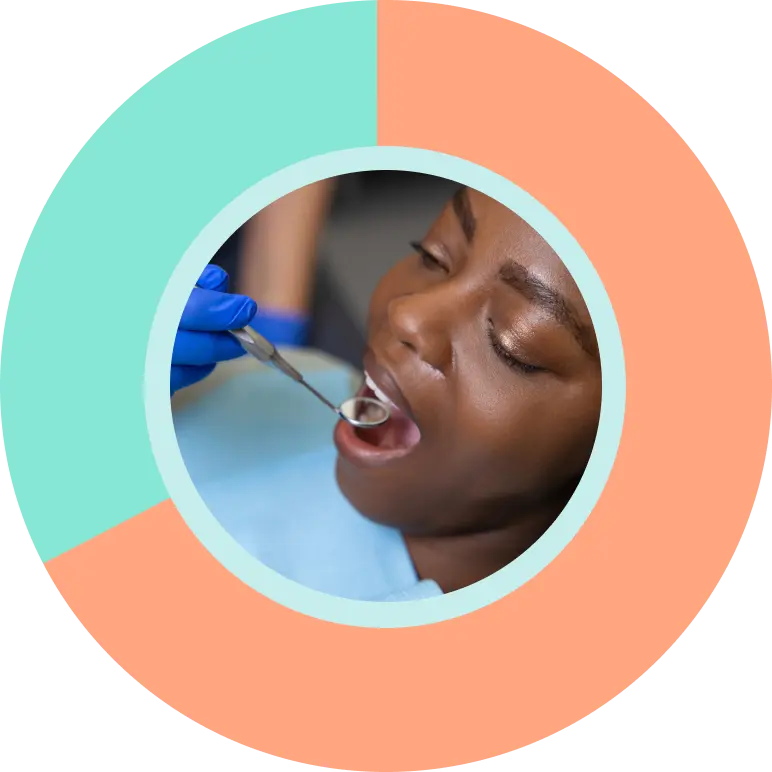
Misconceptions on Oral Health
70% of U.S. adults 30+ say their dental or oral health is excellent/good. But, dentists and hygienists say that only 47% of their adult patients have excellent or good oral health on average. So, many consumers may not recognize the poor state of their own dental or oral health.

70%
of U.S. adults 30+ say
their dental/oral health
is excellent/good
Dentists and
Hygienists say that
only
47%
of their adult patients have
excellent or good oral
health on average


KEY TAKEAWAY
Be sure to ask your dentist or hygienist directly about the state of your oral health and ensure you are practicing proper oral hygiene habits in your homecare routine.
Discussion Disconnect
91% of dentists and hygienists report discussing gum health during at least half of their dental appointments, while only 62% of U.S. adults 30+ who ever visit the dentist report that they discuss gum health at the same frequency.
So, it's important to ensure that patients and their dental care providers are on the same page about gum health management.

91%
of dentists and
hygienists report
discussing gum health
during at least half of
appointments
62%
of U.S. adults 30+
report discussing gum
health during at least
half of appointments


KEY TAKEAWAY
Be sure to proactively ask about gum health and any changes to your risk for gum disease at every appointment.


DID YOU KNOW?
40% of dentists refer to gum disease as “gum inflammation” or “gum infection” because the word “disease” can seem scary to patients.* These misnomers, while technically accurate, can contribute to patient confusion about gum disease and its seriousness.
*See Study methodology at the bottom of the page
What You Need to Know About Gum Disease
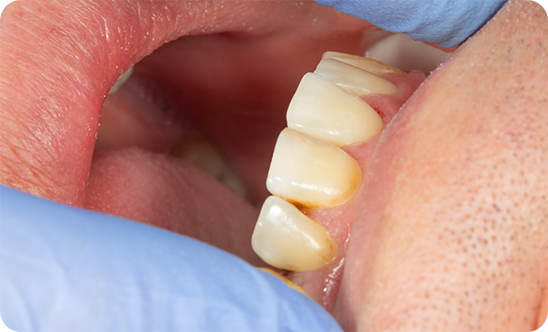
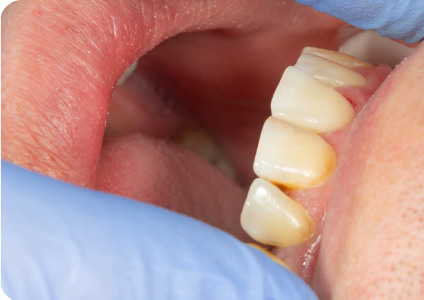
What it is:
Gum disease occurs when plaque accumulation leads to inflammation in the gums. Plaque buildup can ultimately harden into tartar. The gums will begin to detach from the teeth, creating pockets in which bacteria can spread to the roots of the teeth, potentially affecting the health of the bone, gums, and connective tissue.


Factors:
Numerous factors can increase the risk of gum disease, including poor oral hygiene, smoking, genetics, stress, pregnancy, and certain chronic conditions.


Management:
Gum disease is a chronic bacterial infection. Meaning once you have it, it’s with you for life. Luckily, with treatment and monitoring during dental visits, gum disease can be managed.
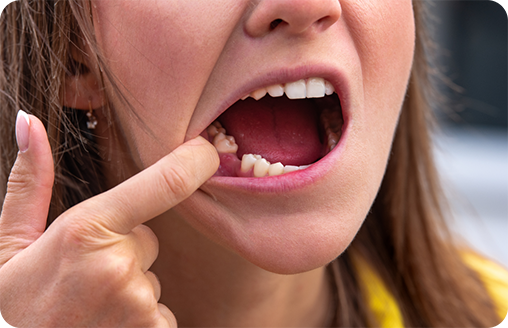
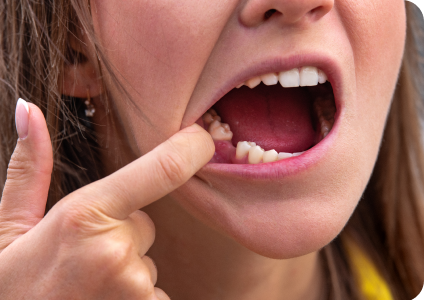
Implications:
When gum disease is not adequately managed, the infection can lead to loose teeth or tooth loss and has even been connected to an increased risk for other chronic conditions throughout the body, including cardiovascular disease.


Recognize the signs:
No amount of brushing and flossing will completely eliminate an active infection. For anyone noticing symptoms of gum disease, they should talk to a dentist as soon as possible. While healthy homecare habits should always be practiced, they are not a substitute for professional gum disease management.


What to do:
To learn more and get the conversation started with your dentist or hygienist, take our gum disease Discussion Guide to your next appointment.


DID YOU KNOW?
91% of U.S. adults age 30+ believe, or are not sure, whether gum disease is curable. It is not.
Ask the Right Questions
Remember, you don’t know what you don’t know.

26%


From understanding the telltale signs of gum disease to creating good oral hygiene habits, come prepared for your next dental appointment with our Discussion Guide, which will equip you with the right questions to ask regarding your oral and gum health.


DID YOU KNOW?
Fewer than 3-in-5 U.S. adults 30+ (56%) regularly visit the dentist at the recommended frequency
(at least every 6 months). In fact, 20% of U.S. adults 30+ say they would rather do their taxes by hand than
visit the dentist’s office.
Methodology
Primary Survey
Method Statement for Dental Healthcare Provider Research
The research was conducted online in the United States by The Harris Poll on behalf of OraPharma among 404 Dental Healthcare Professionals (“DHCPs”), including 201 Dentists (with no specialty or a periodontist specialty) and 203 Dental Hygienists, age 18+ who practice in the U.S., are licensed in the state where they practice, have been in practice for at least 1 year, do not primarily see pediatric patients, and see at least 5 patients with periodontal disease weekly, as well as 1,004 U.S. adults age 30+ (“consumers”). The survey was conducted February 13-27, 2024.
Data are weighted where necessary by age, gender, race/ethnicity, region, education, marital status, household size, employment, household income, and political party affiliation to bring them in line with their actual proportions in the population. Data for Dentists and Dental Hygienists were then combined using a post weight proportional to the population size to create a total for DHCPs.
Respondents for this survey were selected from among those who have agreed to participate in our surveys. The sampling precision of Harris online polls is measured by using a Bayesian credible interval. For this Study, the sample data is accurate to within +3.7 percentage points using a 95% confidence level. This credible interval will be wider among subsets of the surveyed population of interest.
All sample surveys and polls, whether or not they use probability sampling, are subject to other multiple sources of error which are most often not possible to quantify or estimate, including, but not limited to, coverage error, error associated with nonresponse, error associated with question wording and response options, and post-survey weighting and adjustments.
Method Statement for Consumer Research
The research was conducted online in the United States by The Harris Poll on behalf of OraPharma among 1,004 U.S. adults age 30+ (“consumers”). The survey was conducted February 13-26, 2024.
Data are weighted where necessary by age, gender, race/ethnicity, region, education, marital status, household size, employment, household income, and political party affiliation to bring them in line with their actual proportions in the population.
Respondents for this survey were selected from among those who have agreed to participate in our surveys. The sampling precision of Harris online polls is measured by using a Bayesian credible interval. For this Study, the sample data is accurate to within + 3.7 percentage points using a 95% confidence level. This credible interval will be wider among subsets of the surveyed population of interest.
All sample surveys and polls, whether or not they use probability sampling, are subject to other multiple sources of error which are most often not possible to quantify or estimate, including, but not limited to, coverage error, error associated with nonresponse, error associated with question wording and response options, and post-survey weighting and adjustments.
*Supplemental Survey
The research was conducted online in the United States by Sermo on behalf of OraPharma among 100 Dentists. The survey was conducted April 26-27, 2024.





